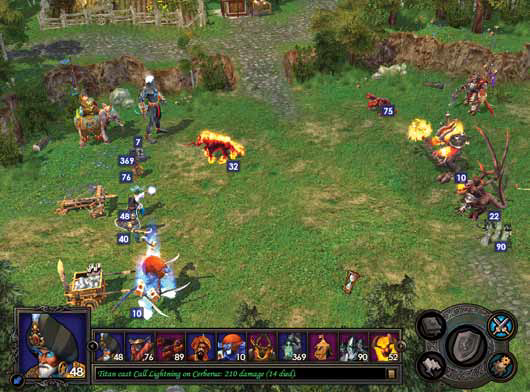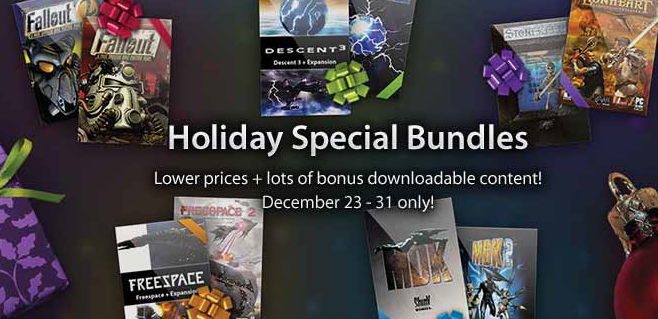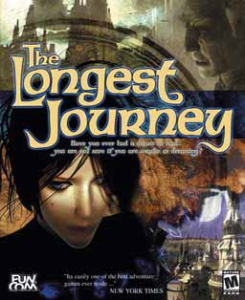SEPT. 25, 2009 • In our ongoing coverage of the major players in digital distribution, DFC looks at the much more specialized Good Old Games (GOG.com) service based in Warsaw Poland. GOG.com was launched in 2008 by games publisher CD Projekt. The latter is considered one of the largest publishers in Central and Eastern Europe and got its start back in 1994 publishing original titles, and later localizing best-selling PC Games from the West for Poland.
Despite the Warsaw home base, GOG.com is a completely English-language operation. The long-term relationship between CD Projekt and Western publishers paved the way for creating a digital distribution service dedicated to bringing AAA catalog PC games back to the market. The big problem for many DOS and Windows 95/98 games is that they have problems installing and running on newer operating systems such as Windows XP and Vista. GOG.com takes that issue out of play by making these older titles compatible when they are added to the service. When consumers download a title, its guaranteed to work. Titles are also made available DRM-free.
GOG.com also gives publishers a painless way to bring their catalog games back to market without issues of package design and retail merchandising. The consumer also wins since they can get a proven game for under $10. At those low price points, and without DRM, DFC believes GOG.com might go further in popularizing digital distribution with a wider cross-section of consumers than more new-release-centric services such as Steam or Direct2Drive.
Describing GOG.com’s business model in greater detail is managing director Adam Oldakowski.
DFC: Can you give us a brief big picture overview of Good Old Games. What is your mission? How have you evolved in recent years?
Adam: Good Old Games, or GOG.com for short, is the ultimate destination for classic PC games, and achieving that goal has been our mission since the beta launch last year. Our aim is to offer the classic games that defined PC gaming, DRM-free and optimized to run on modern operating systems.
Since the launch we’ve brought on close to 30 publishers, including such companies as Interplay, Ubisoft, Codemasters, Apogee, Rebellion and Epic, and offer more than 150 classic PC games. Through attractive pricing and offering players something they can’t get elsewhere – namely, great classic games that will actually work on their PCs, as well as a very personal approach to dealing with our customers – we’ve been able to grow our audience very effectively.
DFC: What percentage of the direct distribution market does Good Old Games hold?
Adam: It’s hard to say what percentage of the market we hold, because that sort of data isn’t easy to come by; we’re still a young company – as noted, we’ve only been around for a year – but we definitely consider ourselves among the top digital distribution outlets around. That said, while we’re very pleased with how well the site has done to date, we also don’t really consider ourselves in competition with the likes of Steam or Direct2Drive – we really focus on providing the best service possible to a particular audience.
DFC: What does your typical consumer look like? How has it changed in recent years? How do you see your consumer base growing?
Adam: Our offerings defines our users, and in a lot of cases we’re attracting customers with nostalgia for the good old days of gaming. Most GOG.com users are people who were raised by those classics and actually played these old games when they were originally released. But we also attract gamers who never had the chance to play some of those titles just because they were too young or perhaps overlooked specific titles. If you think about it, there are thousands of games released every year, and no one really has the time to play everything. At GOG, we’re really doing our best to make sure that people who come to the site can pick from the best games available from various time periods.
We’re really happy with our growth in terms of visitors and paying customers, but we won’t truly be happy until we’ve been able to bring on all of the games we want.

DFC: From a consumer perspective what do you see as the main barriers to acceptance of digital distribution? How are you planning to overcome those barriers?
Adam: Digital distribution faces a few barriers that must be overcome; the lack of a physical copy of the product you buy is a fairly obvious one. People are used to having something physical in their hands when they buy things. With digital distribution you’re only getting data, be it MP3s or videos or game files. We do our best to address that concern by trying to add value and a sense of ownership to our games: every GOG.com user has a virtual shelf – complete with box art – on his or her account, where they can place and organize all of the games they’ve purchased on our site; we allow people to re-download their games anytime they want and install them on as many computers as they wish; and we also offer additional content, like manuals, artworks and game guides – everything in printable files – again, to add value to the overall product offering.
In addition to the perception of physical ownership, a lot of traditional consumers seem to take issue with restrictive copy protection – games that require you to be online to play, to activate your product online, etc. We’ve obviously addressed this issue by ensuring that each of our titles is offered without DRM (digital rights management) that could negatively impact their gaming experience.
DFC: How do you bring consumers to your store? Is there any way a service like Good Old Games can capture the impulse purchase or are you more a destination once someone has made a purchase decision?

Adam: I would point to our unique offerings again as the main reason people come to GOG.com. While other digital-distribution services focus on new releases, we’ve found our niche in offering old games that are difficult to find in stores or don’t work on modern operating systems. Not everyone has a lightning-fast PC that will run the latest hits, and with the propagation of laptops and e-machine-type PCs, sites like ours are an attractive destination for people who are into gaming, and even for those who are just curious about the medium.
We only have two price points –$5.99 and $9.99 – so our games are, essentially, already in impulse-buy territory. In most cases the $5.99 games work as an impulse buy, while the $9.99 games have to be strong titles to convince our users to make the purchase. We also run time-limited promotions every week, and we do a lot of work to highlight games that people may have missed. It’s a testament to the hard work of our team that most of the people who come to GOG and buy a game end up becoming regular customers, and often get deeply involved in our community.
DFC: If a publisher comes to you with a back catalog of titles, what are your recommendations/criteria as to which games should go on GOG.com?
Adam: The criteria for games we release on GOG comes from the name of the service: Good Old Games. We do our best to offer acclaimed titles that were well received by critics and gamers. In our catalogue you will also find games that went under a lot of people’s radars – maybe because of poor marketing or a less-than-favorable release date – but are considered by many gamers as cult classics and represent the best in PC gaming.
As for the “old” part of the name, basically we don’t offer anything that has been newly released. The games we focus on tend to be four to five years years old. We can go back as far as we want, really – if our users want games from the 80s, they’ll get them. Right now most of the games we sell were originally released in the late 90s and early 2000s.
DFC: How many users are regular visitors to GOG.com? How many of those will browse new listings as opposed to coming to the site for a specific title?
Adam: I can’t share specific user numbers, but we do have a very dedicated fan base, as I’ve noted. We have a lot of customers who purchase a significant number of our titles – there are several who own every game (or close to it) in our catalogue. We reach out to fans in a number of ways – through Twitter and Facebook, newsletters, our forums, etc. – to show them new releases or games they may have overlooked, so a good percentage of our users are drawn to the site regularly. And our user base is constantly growing, so we have new customers coming in all the time.
DFC: Have you created specific programming templates that can easily update a DOS or Windows 95 title for play on XP and Vista? Or is updating each game a title-by-title process.
Adam: The process of optimizing games to run under modern operating systems differs from title to title. Our programming team approaches every game as an individual project, because a wide range of issues could arise with each game, and the team has to come up with ways to solve them. With DOS games we’ve been helped by the developers of DOSBox; games from that era are often packed with the DOSBox program to make it even easier to play them on XP and Vista. Thanks to their help – and other groups like ScummVM – we can be sure that the games will run well on our user’s computers.
DFC: Using Duke Nukem 3D as an example, attempting to install the game in Windows XP will usually result in no audio since the original programming wants direct access to sound hardware that XP does not permit. How do you get around that?
Adam: That’s really a question to our programming team, and we can’t really reveal our methods. Suffice to say, we couldn’t do this without a bit of magic from our programmers.

DFC: Most publishers have never found a a method to adequately merchandize and market their back catalogs of games. Has GOG.com solved that problem? If so, why?
Adam: The retail market for PC games has been shrinking dramatically – particularly in North America – and as shelf space has dwindled, so, too, has publishers’ interest in the medium; add to that the amount of work that has to go into making classic games compatible with modern PCs, and the investment required probably wasn’t too appealing. GOG was really one of the first companies to even think about helping publishers monetize their back catalogues through digital distribution; as you’ve surely seen, other distributors are catching on and are bringing older games to their platforms. In that way I think GOG really opened up publishers’ eyes – there are a lot of gamers who want to play these older games.
Thanks to GOG.com, publishers don’t even have to worry about the compatibility with new operating systems, as we do all that work ourselves. So actually the publishers don’t take any risk, as we take care of optimization, promote the games, sell them and distribute them to customers, so publishers can focus on their new titles.
DFC: Do you do any co-op marketing with publishers? Is this an area for expansion or distinction from competing distribution services?
Adam: It’s pretty hard to convince publishers that working on marketing old titles would bring them huge profits. As mentioned, publishers, naturally, are focused more on their upcoming new releases and push all of their resources on those new projects. Monetizing their back catalogues is an additional source of revenue, but still not the main one. I do think that classic games could benefit from an additional publisher-side marketing push, though. If a player frequents a publisher’s website, for example, he or she may very well want to jump on the offer of a classic game from the company.
DFC: What do margins look like for publishers? How do they compare with traditional retail? How do they compare with other online distribution services?
Adam: I can’t reveal this information for confidentiality reasons. The digital space, in general, should allow publishers to keep costs low – for themselves and for consumers – while keeping margins high.
DFC: What percentage of a sale from GOG.com goes back to the publisher?
Adam: Again, I can’t reveal such numbers as it’s are confidential information included in our agreements with publishers.

DFC: What are the highest revenue generating genres on GOG.com?
Adam: These would be the genres that were most popular back in the day – RPGs, point-and-click adventures and strategy games. Because these genres were so popular in the 90s, a lot of amazing games were developed, and those titles that struck a chord with gamers at the time do exceptionally well at GOG.com.
DFC: What total number of sales can an average title generate in specific genres?
Adam: We don’t divulge specific sales info, but suffice to say, the average game at GOG.com can sell thousands of copies.
DFC: What are your plans for international expansion?
Adam: Our goal has been – and always will be – to offer the best possible product to our customers. For now that means that we’re focusing on the English-language site and products. However, we have a sizable international fan base, and we’re always looking for ways to better cater to those gamers. In the future we’ll look at bringing in localized versions of the games, we hope to localize the site itself for various territories, and we’ll also look into expanding payment options for international gamers. These are all long-term plans, though, and for now we still have work to do to make our current site as good as we’d like it to be.

